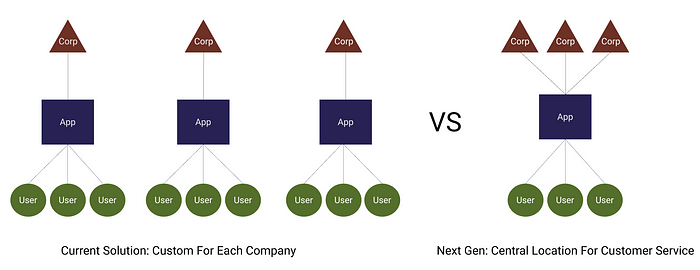Common Sense Customer Service: Chopping Down Phone Trees.
Calling customer support is a task I dread. What about you?
Current Solutions
Take a look at the screenshot below. I grabbed this from NICE, a large company that provides customer support solutions. They proudly tout all their “interaction channels” using “omnichannel routing” that “ empowers your agents to positively and productively interact with customers in digital and voice channels.”

When we strip away all the fancy buzzwords, what are they offering? Phone, texting, email, social media, and messaging app integrations.
Why It Sucks
Now, the messaging app integrations (a pretty new feature that few companies are using) are nice, but all the other channels don’t work as advertised. Calling a company usually means painfully navigating through their phone tree (known as IVR, “Interactive Voice Response”. This is the voice recognition tech that makes you boiling mad for misunderstanding your “No” response as a “Yes”). Even when I can quickly reach a human being (unusual) I usually get passed between several departments, having to reintroduce myself, my problem, and all my details, until I find the right person to talk to.
If the connection is poor, or someone has an accent, there will be difficulty communicating. Having to phonetically spell your name (“A as in Apple, “M as in Mark”) is slow and annoying, especially if you need to repeat it.
The average person spends 43 days of his life waiting on hold.
Web chats are just as bad. Every time I click one of those I know I need to dedicate the next 30 minutes to chatting with the agent, painfully explaining all the details of my problem, and it will usually end with them telling me that they can’t help (sorry), or that I need to call in.
The only good texting customer support I’ve ever received is from the banking app Simple (which I love).
Social media support can be hit or miss, although is sometimes very good. I just don’t feel like airing my problems on Twitter to the whole world, in order to get a response from a company.
More than 50% of people say >2 minutes on hold is too long.
The problem is, all of these solutions, even social media based customer service are built on top of platforms that were never designed to provide true customer support, but were shoehorned in.
Imagine trying to optimize horses with AI-powered routing services instead of switching your company to using motor vehicles. Businesses spend billions every year trying to ensure high quality customer service by developing AI, machine learning systems and other fancy tools, but are trying to optimize a fundamentally flawed system.
A further issue, COVID-19, which has drastically reduced face-to-face interactions, the most reliable manner to resolve a problem. Now that going into the office to speak to someone in person is no longer an option, business and consumers need a platform that can allow them to easily and clearly communicate their issues and details, while removing basic deficiencies inherent in communicating from a distance.
The Solution
A platform designed, from inception, to act as a central hub for customer service interactions.
Most every company I am a customer of requires me to maintain an account with them. The constant logging in, updating information, scrambling to find account numbers, etc, make it annoying to be a consumer. Even when companies create a custom platform for customer service, it’s localized to their app and their company. You will need to download a separate app for each company you deal with, something nobody is interested in doing.

The genius of this architecture is that my application acts as a hub for companies, and is not company-specific. End users download a single application and can then communicate with each company signed up as a provider.
Features
User Info Available App-wide
Because this app is a hub for multiple companies, you fill out your information just once, and grant (or revoke) permission to different companies to access it, if necessary (your banks needs your phone number. Pizza Hut does not need your SSN). This ensures companies receive up-to-date info, and that you don’t need to fill out a billion forms asking for your DOB, name, height, and favorite ice cream flavor.

Document Upload
Car dealership wants a copy of your license to schedule a test drive? Doctor needs your medical insurance card? Don’t bother trying to fax (Yeah. Some people still use fax. Crazy world…) or email it to some catch-all address for the agent to sift around. Take a quick photo and upload it directly to the agent, without dropping the call.
In-app VoIP Calling
In-app calling removes the need for manual authentication (“What is your SSN/Credit Card number?” ) in favor of app-based authentication. The platform knows automatically who is calling. This is common practice. Making a food purchase over the phone requires manual authentication but using a food delivery app is automatic. Think Uber vs taxi. Hotel vs AirBnB. Etc.
App-based Department Navigation
Instead of sitting through soul destroying phone trees, navigate swiftly with simple touch navigation you’ve enjoyed since Steve Jobs invented the iPhone.

With simple touch navigation, users can go forwards and backwards (without having to hang up and listen to all the prompts again) and find the correct department to solve their issue.
Intelligent Callbacks
Due to in-app communication we can implement clever features such as:
- Easily showing the customer their current place in the queue.
- Allowing customers to drop backwards in the queue (you need 20 minutes to finish an important call that just came in).
- Allowing customers to order a callback at a certain time.
- Sending push notification shortly before callback.
- Data capture and analytics is much easier than on phone systems.

Appointment Scheduling
Users can manage all their appointment scheduling with a company.
App-based Data Input
Type your name, address, phone number. Don’t waste your breath trying to repeat it to the outsourced support agent who doesn’t understand English. Typing in your info is faster and less error prone.
Upsell Customers
Businesses can offer one-click offers (“Simply tap to upgrade to a larger data plan.”).
Easy to Modify Decision Trees
Companies are also given greater flexibility to rearrange menu options when they find ways to reduce and improve choices instead of re-recording long and complex audio phone trees.
Integrated Directly in CRMs
The application will be directly integrated into popular CRMs such as SalesForce and Zendesk to allow companies to maintain their tracking, metrics, and ticketing systems.
Challenges
As with every new idea, there are sure to be challenges. Here are some of the ones that I’ve considered.
Widespread Adoption by End Users
Getting users to download a new app is hard. We need to provide a compelling reason for them to do so. I believe that with a no-nonsense approach and marketing that honestly portrays the genuine frustrations of the current customer support solutions, we will be successful.
Adoption by Businesses
Many businesses are slow to change. Even though the current support solutions are fundamentally flawed, it may be challenging to ask businesses to change the status quo and try something new. We must present compelling data and evidence of the significantly increased ease of use and customer satisfaction.
Tech Challenges
Integrations with various CRMs may be complex. Building out the platform itself is sure to be a challenge, as building any large-scale software platform is.
Data Compliance
Certain industries may require additional data compliance. I intend to avoid such issues at early stages, such as avoiding handling and storing medical and payment information.
Data Privacy
Because we are storing and serving user data to various companies we will need to ensure that that data is protected from hackers and unethical businesses practices.
Conclusion
I believe there is a better way to do customer support. I am not satisfied with the current solutions. Wanting to cry is not an indicator of proper service.
My metric for success is “Do I want to cry if forced to call this company’s customer service center?”
Spread the word or join the team and bring customer service out of the torture chambers and into modern life.
Investors
We are open to speaking with investors.
Our Team
We are looking for one or two experienced software developers to join our team.
Please reach out if you hate phone trees and want to make a better customer experience possible, just so that one day you won’t have to suffer on hold until you scream.
Menachem Bakaleynik
Founder
Software Developer
Entrepreneur
Zev Blokh
UI/UX Designer
Marketing
